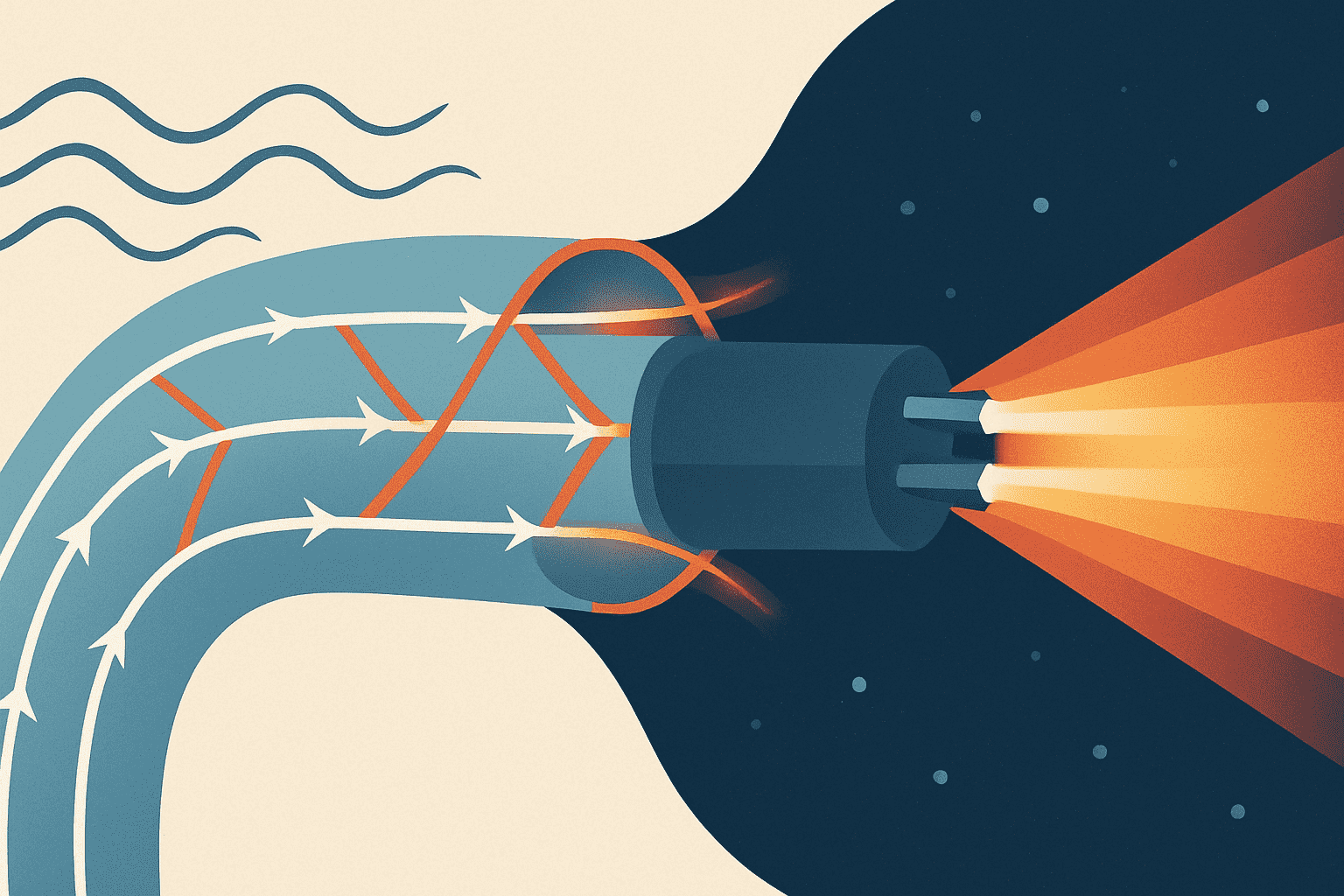Optical fiber is a data transmission method that makes use of light pulses traveling down a long fiber, often constructed of plastic or glass. The less signal damage metal wires can cause the better for optical fiber connection. Additionally, electromagnetic interference does not impact optical fibers. The total internal reflection of light is used in the fiber optic cable.
Structure of optical fiber:
Figure :- 1
The core, cladding, and outer coating are all components of an optical fiber. While glass and plastic are commonly utilized, various materials can be used based on the desired transmission spectrum.
The section of the fiber that transmits light is called the core. The material used for cladding often has a lower refractive index than the core (usually about 1 percent lower). Because of the index difference, total internal reflection occurs at the index border along the length of the fiber, preventing light from escaping through the sidewalls.
Different types of optical fiber
There are different types of optical fiber that are differentiated based on the following parameters:
- Material
- Number of modes
- Refractive index profile
1. Material used:
In terms of the materials utilized, optical fibers are divided into two categories:
- Glass fiber
Example:
- Core: SiO2 Cladding: SiO2
- Core: GeO2– SiO2 Cladding: SiO2
- Plastic fiber
Example:
- Core: Made of Polystyrene : Cladding: Done with Methyl Methacrylate
- Core: Made of Polymethyl Methacrylate : Cladding: Done with Co-Polymer
2. Total number of modes:
In terms of the total number of modes, optical fibres are divided into:
- Single-mode fiber
Single-mode fibers are typically step-index fibers. Doped silica is the raw material used to produce these fibers. In order to allow only one way of transmission, it has an extremely small core diameter.
- Multimode fiber
Both step-index and graded-index fibers benefit from the use of multi-mode fiber. Multi-component glass compounds such as Silica – Clad – Silica, Glass – Clad Glass, doped silica, etc., are used to make the multi-mode fibers.
3. Refractive index profile
Optical fibers are further divided into two groups based on their refractive index profile.
- Step Index Fiber
- Single Mode Step Index Fiber: In a single-mode step-index fiber, the core is surrounded by a lower refractive index cladding than the core itself.
- Multimode Step Index Fiber: The core of a multimode step-index fiber is surrounded by cladding with a lower refractive index than the core.
- Graded Index Fiber
Graded index fibers have refractive indices that vary from one end of the fiber to the other, which causes light rays to move at varying rates. There is a lower refractive index of optical fiber at the outer border of the object. To put it in another way, the rays on the outer edge travel faster than the rays in the centre. As a result, rays leave and arrive at the fiber’s end almost simultaneously.
Applications of different types of optical fiber
Compared to typical metallic wires, the application of optical fiber has proven advantageous.
Applications of optical fiber communication:
- Medical industry: In several instruments, it is utilized to observe interior body components by entering into hollow places in the body because of its thin and flexible nature. Surgical lasers, endoscope lasers, microscope lasers, and biomedical lasers all make use of fiber lasers.
- Communication: Optical fiber cables play an important role in the principle of optical fiber communication systems because they are used for both transmission and reception. Speed and accuracy can be improved by using it in many networking applications.
- Defense: High-level data security sectors of military and aerospace applications use fiber optics for data transfer. Hydrophones for SONAR and seismic applications, as well as aviation wiring, make use of this material.
- Broadcasting: Such cables deliver high-speed, high-bandwidth HDTV signals. When compared to the same amount of copper cables, fiber optic cable is less expensive. Broadcasters employ optical fibers to connect HDTV, CATV, VOD, and other services.
- Decorations and lighting: Now that we know what optical fiber is, we can see why it’s so popular in Christmas decorations and trees: it’s inexpensive, easy to use, and beautiful.
Principle of operation
Optical fibers operate based on the principle of total internal reflection phenomenon that occurs at the interface between the core and the cladding provided that the angle of the incident light inside the core is higher than the angle called critical angle. Therefore the incident light will get reflected back into the core and propagate along the fiber. If the light strikes the interface at an angle greater than the critical angle, it will not pass via the other medium. The reflected light at the interface is proportional to the angle of incidence as well as the refractive indices of the core and cladding. The total internal reflection phenomena are shown in Fig. 2. As it can be seen from Fig. 2(a), the light encounters an interface between two mediums with different refractive indices as glass and air. The light will pass through the air medium if the angle of incident (θi) is
smaller than the critical angle (θc) and it will be refracted back into the same medium as glass if θi > θc. Fig. 2(b) shows the same concept, where the two glass mediums have different refractive indices in the fiber structure. The core section with a higher refractive index will guide the light through the total internal reflection phenomena, therefore the same concept is governed as described in Fig. 2(a). Fibers usually have one core and one cladding along with a protective coding. From Fig. 3, the optical fiber consists of four parts namely, core, cladding, buffer and the jacket. The core section has a cylindrical shape made of dielectric material and generally has a special refractive index. The core section is surrounded by the cladding section which is made of glass or plastic with a lower refractive index than the core section. The cladding section performs a few functions such as reducing the loss of the light from the core into the surrounding air. The cladding section is surrounded by an additional elastic layer as a buffer made of plastic which protects the optical fiber from physical damage and scattering losses caused by the micro bending. The last layer is the jacket layer which can be used to recognize the fiber’s type. Most fibers are made of quartz glass because of through. This core is also surrounded by a cylindrical layer of material which has a lower refractive index and is known as cladding. The refractive index difference is 0.005. The function of the jacket is to protect the core .
Fig. 2. Total internal reflection, (a) in glass and air mediums, (b) in fiber structure which has two glass mediums with different refractive indices. S. Addanki et al. Results in Physics 10 (2018) 743–750 .
ii Planar waveguide fiber
This type of fiber is made of the rectangular block containing three layers as the base, light guide, and coating. The refractive index of the base and that of the coating are lower than other layers. Based on the mode number
i. Multi-mode fiber
This type of fiber is applicable to short distance communications such as local area network systems and video surveillance . It has a very large core diameter of 50–62.5 μm. The large diameter of the core pushes the impulse to pass along different optical routes in random mode, hence, the rays move to touch the detector at dissimilar times. It causes temporary broadening of the signal, hindering data transmission speed and effective broadcast distance to about 200–500 m.
ii. Single-mode fiber
Single-mode fibers, on the other hand, are better used for longer communication distances, which are appropriate for the long-distance telephone as well as multi-channel TV transmission systems. Single Mode fibers have small core diameters of 5 or 10 μm. The diameter of the cladding in the multi-mode and single-mode fibers is 125 μm as shown in Fig. 4.
Fig. 4. Dimensions of the single-mode and multi-mode fibers, the single-mode, and multi-mode fibers have core diameters of 9 μm and 50 μm respectively, where these have a cladding diameter of 125 μm.
Utilized for both guiding light and amplifying. The core has a highest refractive index and the outer cladding has a lowest refractive index and it can be made of materials such as polymers. DCF features a single-mode core and double cladding structures that allows both single-mode and multi-mode light to propagate through the fiber. Triple-clad single-mode fibers have been attracted because perfect transmission properties can be obtained by adjusting the cladding parameters. Optical fibers consisting of multi-cores are new approaches to engineer the fibers for high capacity transmission applications. These types of fibers are functioning in both single and multiple modes and can be made of several cores. Each of the fiber cores can act as a separate waveguide in which the light can propagate independently. The mode coupling occurs between the cores if the distance between two cores is too small. Even though in some situations this type of light coupling is desired, in many others, it is avoided or minimized by using large enough spacing between the cores.
– Dr. Mamataben Soni
Associate Professor, FOBAS, Madhav University

